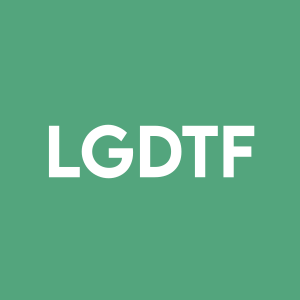Liberty Gold Reports Resource Upgrade Drill Results from the Main Zone - Hamburg Pit, Goldstrike Oxide Gold Deposit, Utah
Rhea-AI Summary
Liberty Gold Corp. (TSX: LGD; OTCQX: LGDTF) announced promising results from its 2021 Reverse Circulation drill program at the Goldstrike Oxide Gold Project in Utah. The program aims to convert resources from Inferred to Measured and Indicated status. Key findings include significant gold grades, such as 0.81 g/t Au over 61.0 m and 1.48 g/t Au over 15.2 m. Nearly 75% of the Goldstrike resource is categorized as Indicated. The project demonstrates economic viability, with an NPV of approximately US$291.7 million and an IRR of 52.4% at current gold prices.
Positive
- Drill results indicate continuous, well-mineralized corridors, enhancing resource modeling confidence.
- Approximately 75% of Goldstrike's resources classified as Indicated, suggesting strong potential for mineral extraction.
- Favorable permitting conditions with 40% of the Main Zone on private patented lands.
- Reported NPV of US$291.7 million and IRR of 52.4% at US$1,700/oz gold prices highlight robust economic returns.
Negative
- None.
News Market Reaction 1 Alert
On the day this news was published, LGDTF gained 17.28%, reflecting a significant positive market reaction.
Data tracked by StockTitan Argus on the day of publication.
PGS 773: 0.81 g/t Au over 61.0 m, including 1.48 g/t Au over 15.2 m
PGS 759: 0.61 g/t Au over 70.1 m
VANCOUVER, B.C., Oct. 20, 2021 (GLOBE NEWSWIRE) -- Liberty Gold Corp. (TSX: LGD; OTCQX: LGDTF) ("Liberty Gold" or the "Company") is pleased to announce additional results from its 2021 Reverse Circulation (“RC”) drill program at the Goldstrike Oxide Gold Project in southwestern Utah (“Goldstrike”).
A 15,000 metre (“m”) RC drill program at Goldstrike commenced June 2021, focused on resource conversion from “Inferred” to “Measured and Indicated” and testing areas where the deposit remains open laterally and to depth. Drill results in this news release are from the Hamburg Pit area, part of the Main Zone, which hosts greater than
Goldstrike is a past-producing, oxide, heap leach gold mine that contains a large, shallow, district–scale, Carlin-style gold system. It follows a 7 kilometre-long, north-dipping unconformity with higher-grade gold intervals located along west-northwest-striking faults. In 2018, a Preliminary Economic Assessment1 (“PEA”) was completed at Goldstrike which returned a Net Present Value at a
Cal Everett, President and CEO of Liberty Gold stated, “The Goldstrike Project in southwest Utah, coupled with Black Pine in southeastern Idaho, represent two high-quality, oxide gold development assets in the Great Basin, USA. While our focus has been on Black Pine for the last two years, with the rise in gold price and increased market recognition of Goldstrike, we have returned to the project this year to continue de-risking the asset towards a pre-feasibility study decision. The objective of the 2021 drill program is to continue to push the pit constrained, 925,000 oz Indicated Resource outwards and downwards with the goal to upgrade the 296,000 oz Inferred Resource.”
KEY POINTS: MAIN ZONE – HAMBURG PIT
- Main Zone drilling to date has focused on the historic Hamburg Pit area, including Inferred Resource blocks located adjacent to and beneath the well-drilled Indicated portion of the Mineral Resource.
40% of the Main Zone is located on private patented lands, a favourable permitting consideration.- Approximately
75% of the Goldstrike resource is in the Indicated category. - Drilling is encountering long intervals of oxide gold mineralization with excellent cyanide solubility at shallow depths, increasing the confidence in historic drilling and supporting the continuity of mineralization in corridors throughout the Main Zone.
- Liberty Gold will continue to de-risk the Goldstrike Deposit through concurrent engineering, drilling, updated metallurgy and procurement of process water in line with all social license obligations and considerations.
- Total meterage drilled at Goldstrike to mid-October 2021 is 11,544 m in 80 holes, of which 2,546 m in 19 holes are reported herein.
MAIN ZONE HIGHLIGHT TABLE*
| Hole ID (Az, Dip) (degrees) | From (m) | To (m) | Intercept (m) | Au (g/t) | Au Cut-Off | Hole Length (m) | Target | AuCN/AuFA (%) | ||
| PGS756 (240, -70) | 44.2 | 62.5 | 18.3 | 1.07 | 0.2 | 129.5 | Hamburg | |||
| also incl | 50.3 | 57.9 | 7.6 | 1.52 | 1.0 | |||||
| and | 80.8 | 86.9 | 6.1 | 0.75 | 0.2 | |||||
| incl | 82.3 | 83.8 | 1.5 | 1.17 | 1.0 | |||||
| PGS757 (170, -70) | 39.6 | 51.8 | 12.2 | 0.95 | 0.2 | 132.6 | Hamburg | |||
| incl | 47.2 | 50.3 | 3.0 | 2.49 | 1 | |||||
| and | 61.0 | 68.6 | 7.6 | 0.54 | 0.2 | |||||
| and | 88.4 | 93.0 | 4.6 | 1.02 | ||||||
| incl | 88.4 | 91.4 | 3.0 | 1.24 | 1 | |||||
| PGS758 (020, -50) | 74.7 | 141.7 | 67.1 | 0.62 | 0.2 | 178.3 | Hamburg | |||
| incl | 77.7 | 80.8 | 3.0 | 1.76 | 1 | |||||
| also incl | 88.4 | 89.9 | 1.5 | 1.02 | ||||||
| also incl | 121.9 | 123.4 | 1.5 | 2.31 | ||||||
| also incl | 125.0 | 126.5 | 1.5 | 1.04 | ||||||
| PGS759 (355, -50) | 70.1 | 140.2 | 70.1 | 0.61 | 0.2 | 141.7 | Hamburg | |||
| incl | 94.5 | 100.6 | 6.1 | 1.74 | 1 | |||||
| PGS760 (0, -90) | 47.2 | 71.6 | 24.4 | 0.43 | 0.2 | 144.8 | Hamburg | |||
| incl | 64.0 | 65.5 | 1.5 | 1.12 | 1 | |||||
| PGS761 (290, -65) | 48.8 | 80.8 | 32.0 | 0.38 | 0.15 | 166.1 | Hamburg | |||
| also incl | 54.9 | 80.8 | 25.9 | 0.42 | 0.2 | |||||
| and | 89.9 | 103.6 | 13.7 | 0.88 | 0.15 | |||||
| incl | 89.9 | 100.6 | 10.7 | 1.08 | 0.2 | |||||
| also incl | 94.5 | 97.5 | 3.0 | 2.70 | 1 | |||||
| and | 109.7 | 126.5 | 16.8 | 0.38 | 0.15 | |||||
| incl | 109.7 | 123.4 | 13.7 | 0.42 | 0.2 | |||||
| PGS770 (335, -50) | 22.9 | 48.8 | 25.9 | 0.67 | 0.2 | 129.5 | Hamburg | |||
| PGS771 (5, -85) | 0.0 | 33.5 | 33.5 | 0.28 | 0.15 | 144.8 | Hamburg | |||
| incl | 1.5 | 32.0 | 30.5 | 0.29 | 0.2 | |||||
| and | 41.1 | 53.3 | 12.2 | 0.48 | 0.2 | |||||
| incl | 48.8 | 50.3 | 1.5 | 1.17 | 1 | |||||
| PGS772 (280, -65) | 0.0 | 33.5 | 33.5 | 0.32 | 0.2 | 121.9 | East Hamburg | |||
| and | 41.1 | 54.9 | 13.7 | 0.44 | 0.15 | |||||
| incl | 44.2 | 54.9 | 10.7 | 0.51 | 0.2 | |||||
| also incl | 50.3 | 53.3 | 3.0 | 1.14 | 1 | |||||
| and | 62.5 | 67.1 | 4.6 | 0.45 | 0.15 | |||||
| incl | 62.5 | 65.5 | 3.0 | 0.58 | 0.2 | |||||
| PGS773 (25, -50) | 32.0 | 94.5 | 62.5 | 0.79 | 0.15 | 105.2 | East Hamburg | |||
| incl | 32.0 | 93.0 | 61.0 | 0.81 | 0.2 | |||||
| also incl | 35.1 | 36.6 | 1.5 | 1.33 | 1 | |||||
| also incl | 39.6 | 54.9 | 15.2 | 1.48 | ||||||
| also incl | 71.6 | 73.2 | 1.5 | 1.24 | ||||||
| PGS774 (345, -75) | 35.1 | 82.3 | 47.2 | 0.45 | 0.15 | 99.1 | East Hamburg | |||
| incl | 38.1 | 73.2 | 35.1 | 0.48 | 0.2 | |||||
| also incl | 74.7 | 80.8 | 6.1 | 0.59 | ||||||
*Please refer to the full table at the link below for complete results. Results are reported as drilled thicknesses, with true thicknesses varying by hole orientation. True thicknesses are generally
For a map and cross sections of the Goldstrike Property, including drill collars and traces for the current release, please click here:
https://libertygold.ca/images/news/2021/October/Goldstrike_NR10202021MapSection.pdf
For a complete table of drill results from all Liberty Gold drill holes at Goldstrike, please click here: https://libertygold.ca/images/news/2021/October/GS_Intercepts10202021.pdf
ABOUT GOLDSTRIKE
Goldstrike is located in the eastern Great Basin, immediately adjacent to the Utah/Nevada border, and is a Carlin-style gold system, similar in many ways to the prolific deposits located along Nevada’s Carlin trend. Like Black Pine and Nevada Gold Mines Long Canyon deposit, Goldstrike represents part of a growing number of Carlin-style gold systems located off the main Carlin and Cortez trends in underexplored parts of the Great Basin.
Goldstrike is a past-producing, open-pit run of mine heap-leach operation that produced 209,000 ounces of gold and 197,000 oz of silver between 1988 and 1994 during a period of historically low gold prices. Ore was mined from 12 shallow pits, at an average grade of 1.2 g/t Au and an average recovery of approximately
The 2021 drilling campaign is designed to convert areas of inferred resource to indicated resource in support of a Prefeasibility Study decision and will also test for extensions to mineralization in several areas.
A virtual site tour and 3D model of the Goldstrike property, including details about the geology and mineralization, is available on the Company’s website: libertygold.ca
QUALITY ASSURANCE – QUALITY CONTROL
Drill composites were calculated using cut-offs of 0.15 g/t, 0.20 g/t and 1.00 g/t gold. Drill intersections are reported as drilled thicknesses. True widths of the mineralized intervals vary between
QUALIFIED PERSON
Moira Smith, Ph.D., P.Geo., Vice-President Exploration and Geoscience, Liberty Gold, is the Company's designated Qualified Person for this news release within the meaning of National Instrument 43-101 Standards of Disclosure for Mineral Projects ("NI 43-101") and has reviewed and validated that the information contained in the release is accurate.
ABOUT LIBERTY GOLD
Liberty Gold is focused on exploring the Great Basin of the United States, home to large-scale gold projects that are ideal for open-pit mining. This region is one of the most prolific gold-producing regions in the world and stretches across Nevada and into Idaho and Utah. We know the Great Basin and are driven to discover and advance big gold deposits that can be mined profitably in open-pit scenarios. Our flagship projects are Black Pine in Idaho and Goldstrike in Utah, both past- producing open-pit mines, where previous operators only scratched the surface.
For more information, visit www.libertygold.ca or contact:
Susie Bell, Manager, Investor Relations
Phone: 604-632-4677 or Toll Free 1-877-632-4677
info@libertygold.ca
All statements in this press release, other than statements of historical fact, are "forward-looking information" with respect to Liberty Gold within the meaning of applicable securities laws, including statements that address potential quantity and/or grade of minerals, the potential size of the mineralized zone, , drill results demonstrating the presence of continuous and well-mineralized corridors in the Main Zone area and building confidence in the resource modeling, plans with respect to exploration and development plans of Goldstrike and the timing thereof, the objectives of the drilling program, the potential upgrade of inferred mineral resources to measured and indicated mineral resources and plans for any Prefeasibility Study decisions. Forward-looking information is often, but not always, identified by the use of words such as "seek", "anticipate", "plan", "continue", "planned", "expect", "project", "predict", "potential", "targeting", "intends", "believe", "potential", and similar expressions, or describes a "goal", or variation of such words and phrases or state that certain actions, events or results "may", "should", "could", "would", "might" or "will" be taken, occur or be achieved. Forward-looking information is not a guarantee of future performance and is based upon a number of estimates and assumptions of management at the date the statements are made including, among others, assumptions about future prices of gold, and other metal prices, currency exchange rates and interest rates, favourable operating conditions, political stability, obtaining governmental approvals and financing on time, obtaining renewals for existing licenses and permits and obtaining required licenses and permits, labour stability, stability in market conditions, the impact from the pandemic of the novel coronavirus (COVID-19), availability of equipment, timing of the publication of any PEAs, the availability of drill rigs, successful resolution of disputes and anticipated costs and expenditures. Many assumptions are based on factors and events that are not within the control of Liberty Gold and there is no assurance they will prove to be correct.
Such forward-looking information, involves known and unknown risks, which may cause the actual results to be materially different from any future results expressed or implied by such forward-looking information, including, risks related to the interpretation of results and/or the reliance on technical information provided by third parties as related to the Company’s mineral property interests; changes in project parameters as plans continue to be refined; current economic conditions; future prices of commodities; possible variations in grade or recovery rates; the costs and timing of the development of new deposits; failure of equipment or processes to operate as anticipated; the failure of contracted parties to perform; the timing and success of exploration activities generally; the timing of the publication of any PEAs or pre-feasibilities; delays in permitting; possible claims against the Company; labour disputes and other risks of the mining industry, including impacts from the pandemic of the novel coronavirus (COVID-19); delays in obtaining governmental approvals, financing or in the completion of exploration as well as those factors discussed in the Annual Information Form of the Company dated March 26, 2021 in the section entitled "Risk Factors", under Liberty Gold’s SEDAR profile at www.sedar.com.
Although Liberty Gold has attempted to identify important factors that could cause actual actions, events, or results to differ materially from those described in forward-looking information, there may be other factors that cause actions, events or results not to be as anticipated, estimated or intended. There can be no assurance that such information will prove to be accurate as actual results and future events could differ materially from those anticipated in such statements. Liberty Gold disclaims any intention or obligation to update or revise any forward-looking information, whether as a result of new information, future events or otherwise.
Cautionary Note for United States Investors
The terms “mineral resource”, “measured mineral resource”, “indicated mineral resource” and “inferred mineral resource”, are Canadian mining terms as defined in, and required to be disclosed in accordance with, National Instrument 43-101 – Standards of Disclosure for Mineral Projects (“NI 43-101”), which references the guidelines set out in the Canadian Institute of Mining, Metallurgy and Petroleum (the “CIM”) – CIM Definition Standards on Mineral Resources and Mineral Reserves (“CIM Definition Standards”), adopted by the CIM Council, as amended. However, these terms are not defined terms under SEC Industry Guide 7 (“SEC Industry Guide 7”) under the United States Securities Act of 1933, as amended, and normally are not permitted to be used in reports and registration statements filed with United States Securities and Exchange Commission (the “SEC”). The SEC has adopted amendments to its disclosure rules to modernize the mineral property disclosure requirements for issuers whose securities are registered with the SEC under the United States Securities Exchange Act of 1934, as amended. These amendments became effective February 25, 2019 (the “SEC Modernization Rules”) with compliance required for the first fiscal year beginning on or after January 1, 2021. The SEC Modernization Rules replace the historical disclosure requirements for mining registrants that were included in SEC Industry Guide 7. The Company does not file reports with the SEC and is not required to provide disclosure on its mineral properties under the SEC Modernization Rules and will continue to provide disclosure under NI 43-101 and the CIM Definition Standards.
United States investors are cautioned that there are differences in the definitions under the SEC Modernization Rules and the CIM Definition Standards. There is no assurance any mineral resources that the Company may report as “measured mineral resources”, “indicated mineral resources” and “inferred mineral resources” under NI 43- 101 would be the same had the Company prepared the resource estimates under the standards adopted under the SEC Modernization Rules. United States investors are also cautioned that while the SEC will now recognize “measured mineral resources”, “indicated mineral resources” and “inferred mineral resources”, investors should not assume that any part or all of the mineralization in these categories will ever be converted into a higher category of mineral resources or into mineral reserves. Mineralization described using these terms has a greater amount of uncertainty as to their existence and feasibility than mineralization that has been characterized as reserves. Accordingly, investors are cautioned not to assume that any “measured mineral resources”, “indicated mineral resources” or “inferred mineral resources” that the Company reports are or will be economically or legally mineable. Further, “inferred mineral resources” have a greater amount of uncertainty as to their existence and as to whether they can be mined legally or economically. Therefore, United States investors are also cautioned not to assume that all or any part of the “inferred mineral resources” exist. In accordance with Canadian securities laws, estimates of “inferred mineral resources” cannot form the basis of feasibility or other economic studies, except in limited circumstances where permitted under NI 43-101. In addition, the SEC has amended its definitions of “proven mineral reserves” and “probable mineral reserves” to be “substantially similar” to the corresponding CIM definitions. United States investors are cautioned that a preliminary economic assessment cannot support an estimate of either “proven mineral reserves” or “probable mineral reserves” and that no feasibility studies have been completed on the Company’s mineral properties.
Accordingly, information contained herein describing the Company’s mineral deposits may not be comparable to similar information made public by U.S. companies subject to the reporting and disclosure requirements under the United States federal securities laws and the rules and regulations thereunder.
1 Preliminary Economic Assessment entitled “Preliminary Economic Assessment and Independent Technical Report for the Goldstrike Project, Washington County, Utah, USA” dated July 16, 2018.









